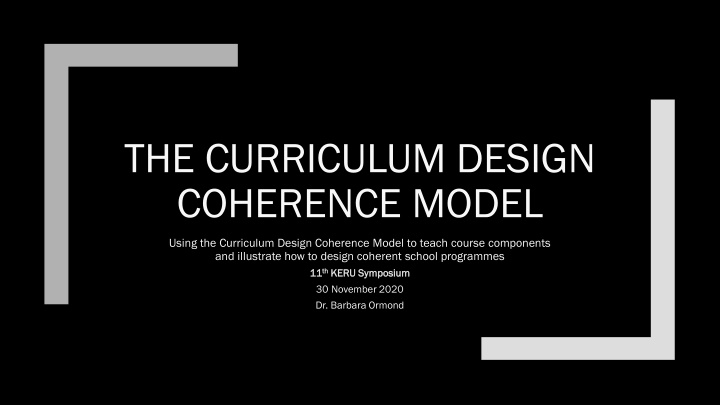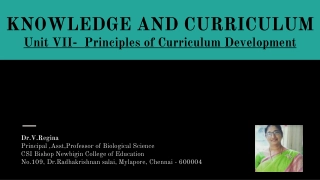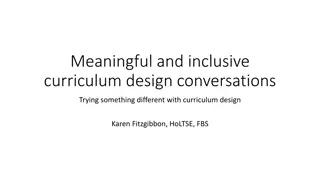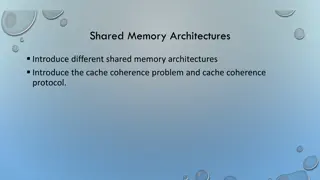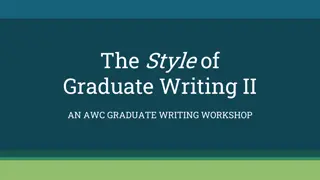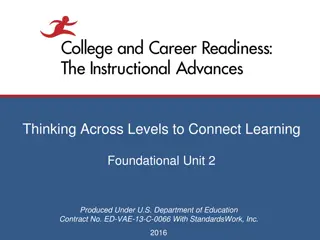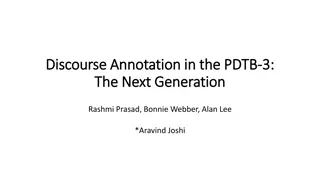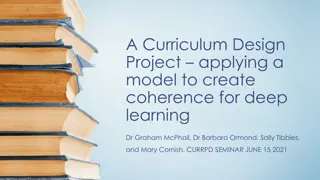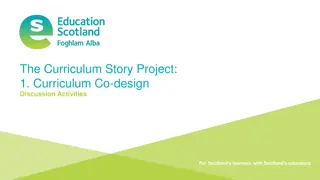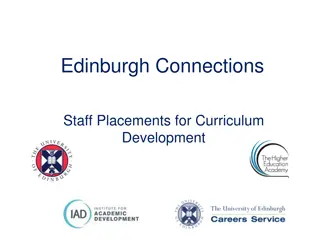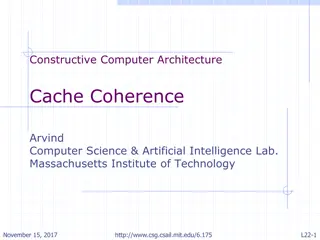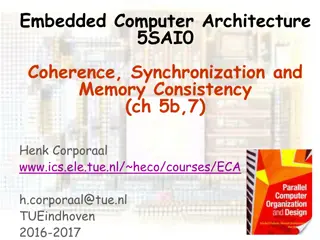Enhancing Teaching Through Curriculum Design Coherence Model
Explore the use of the Curriculum Design Coherence Model (CDC) for designing effective lectures and guiding pre-service teachers in creating coherent lesson plans. Learn about epistemic progression, systematic ordering of knowledge, types of knowledge, and Bernsteins's knowledge structures to design structured and meaningful school programs. Utilize the CDC Model to foster conceptual understandings and subject knowledge among students.
Download Presentation

Please find below an Image/Link to download the presentation.
The content on the website is provided AS IS for your information and personal use only. It may not be sold, licensed, or shared on other websites without obtaining consent from the author.If you encounter any issues during the download, it is possible that the publisher has removed the file from their server.
You are allowed to download the files provided on this website for personal or commercial use, subject to the condition that they are used lawfully. All files are the property of their respective owners.
The content on the website is provided AS IS for your information and personal use only. It may not be sold, licensed, or shared on other websites without obtaining consent from the author.
E N D
Presentation Transcript
THE CURRICULUM DESIGN COHERENCE MODEL Using the Curriculum Design Coherence Model to teach course components and illustrate how to design coherent school programmes 11 11th thKERU Symposium KERU Symposium 30 November 2020 Dr. Barbara Ormond
Outline 1. The use of the CDC Model for designing a lecture, or sequence of lectures, on a particular topic in Initial Teacher Education programmes 2. Teaching pre-service teachers how to make use of the CDC Model for designing their own lessons or units of learning.
Epistemic Progression and Structure Conceptual understandings Subject knowledge Make Develop abstract ideas inferential links
Systematic ordering of knowledge Concepts provide the foundation for systematic ordering of knowledge Systematic ordering enables conceptual progression - to gradually build understanding and make inferential links between concepts Conceptual progression means the concepts already understood by students are brought into new relations of abstraction and generality as further concepts are acquired and integrated into students understanding. (Rata, 2016, p. 172)
Understanding Types of Knowledge 1. 1. Knowledge Knowledge - - That academic knowledge That - - propositional knowledge, , substantive knowledge, This form of knowledge is what you go to school to learn. This is often knowledge which is recognised by academic communities and verified through robust systems of critique. 2. Know 2. Know- -How How- -To To applied knowledge, skills 3. Socio 3. Socio- -cultural knowledge cultural knowledge everyday knowledge This form of knowledge is what you might learn through lived experience
Bernsteins Knowledge Structures Hierarchical knowledge structure Hierarchical knowledge structure Knowledge is progressively subsumed and integrated Horizontal knowledge structure Horizontal knowledge structure Knowledge is made of multiple segments Social Sciences and humanities have a horizontal knowledge structure. This means that there are multiple ways of combining segments of knowledge to form a systematically organised curriculum. In order to make learning meaningful and understandable teachers therefore, need to carefully consider how to organise the learning into a systematic structure. The CDC Model is designed to help with this.
Vygotsky General (higher) concepts Related (subordinate) concepts Difference Similarity Abstract thought
History Example What was the nature of Elizabethan and early Stuart Government? Elizabeth: as a ruler, government, finance, religion, Crown and Parliament in peace and war (Ministry of Education, 1998). Example subject concepts: Royal prerogative - the rights of the monarch to rule as understood by convention Omnicompetence - the all-encompassing powers of a monarch
The CDC Model in Teacher Education ASSESSMENT ASSESSMENT Fairness Transparency Consistency Principles (Concepts) of Assessment Learning and Assessment A Guide to Assessment, NZQA, 1996, p.7 Validity Manageability
TOPIC - ASSESSMENT TOPIC PROPOSITION TOPIC PROPOSITION Fair Fair and reasonable assessment is well aligned to learning, assesses important knowledge and skills, and enables sound assessor judgments to be made. Key Subject Concept(s) Key Subject Concept(s) Fair assessment Related Concepts Related Concepts Principles: fairness, validity, transparency, manageability, consistency Forms: standards-based, norm-referenced
Connecting Subject Concepts to Content Concepts connected to the topic of principles and practices of assessment Concepts connected to the topic of principles and practices of assessment 1. Fairness relates to both the assessment design and the marking of an assessment. The assessment needs to assess knowledge (Knowledge-that) or skills (Know-how-to) which have been taught, unless the form the assessment is a pre-test. To be fair, assessment methods also need to be accessible for all participants. It cannot disadvantage individuals or groups by limiting them in ways unrelated to the evidence sought. (e.g. access to resources needed for the assignment) 2. Validity refers to the relationship between what is required to be assessed (e.g. adhering to a prescription, or mandated outcomes), and the matters being assessed in the assessment tasks. These need to be aligned. Pre-service teachers will be shown how, for example, NCEA assessments align with the requirements of the Achievement Standards. Validity should also be a fundamental principle when considering what knowledge (Knowledge-that) or skills (Know-how-to) are suitable and worthwhile to assess.
The Primacy of subject concepts Further related concepts and examples of connecting concepts and content. Transparency e.g. return of examination scripts Consistency e.g. Profiles of Expected Performance (PEPs) Pre-service Teachers Know-how-to
Pre-service teachers know-how-to knowledge Students need to think about whether the assessment they have written is Fair and transparent - whether it aligns well with the achievement standard Consistent Manageable for students - whether it is consistent with what has been expected in the past -whether there is consistency between what is asked for in the tasks and expected in the marking schedule.
Teaching About Subject Concepts 1. Presentations on subject concepts (next slide) 2. Concepts in Lesson Plan Design 3. Teaching Conceptual Understandings 4. Lecture on the CDC Model Ministry of Education, 2009
Subject Concepts Presentations Instructions: Imagine that you are teaching a selected concept from the list below to a Year 9 or 10 social studies class. Your peers are the imaginary Year 9 or 10 class. Explain the concept and if you have time go beyond a definition of the term, to relate it to a selected example or context. Your presentation should be about 2 minutes long. You may use a whiteboard to explain the concept. You will assess your peers see attached assessment criteria. CONCEPTS: CONCEPTS: Choose one of the concepts below or choose one of your own. Supply and demand Market forces GST - Goods and Services Tax Taxation Entrepreneurship Business and Enterprise Consumption Sustainability Scarcity Needs and wants Multiculturalism Biculturalism Identity Ethnicity Kinship Prejudice Stereotypes Whakapapa Democracy Communism Totalitarianism Monarchy Autocracy The State Migration Urbanisation Turangawaewae Rangatiratanga Sovereignty Hierarchical Society Egalitarianism Suffrage Feminism Populism
The Model 4 steps in the process 4 steps in the process 1. 1. Select and Select and Sequence Sequence Subject Subject Concepts from Concepts from a subject topic a subject topic proposition proposition Subject Subject Programme Programme Course Course Subject Topic Subject Topic 4. Evaluate 4. Evaluate Knowledge Knowledge- - That and That and Know Know- -How How- -To 2. Connect 2. Connect Concepts to Concepts to Content Content To 3. Connect 3. Connect Knowledge Knowledge- - That to Know That to Know- - How How- -To To
Example: Human Rights Students are shown what a proposition is and what it might look like. Topic Topic The Universal Declaration of Human Rights Element 1: Write the topic s proposition Element 1: Write the topic s proposition - - The proposition states what the topic is about. The proposition statement is the way to identify the subject concepts because it contains the key (or superordinate) subject concept(s). The Universal Declaration of Human Rights 1948 is a document which states the intention of contributing nations to uphold and protect the rights of their citizens regardless of peoples ethnicity, religion, beliefs, sex, language, or other status.
Subject Concepts Select the key subject concept(s) of the proposition Select the key subject concept(s) of the proposition Human Rights Select and sequence related subject concepts Select and sequence related subject concepts (Note: sequence may not mean the order of lessons a sequence could mean creating a logical structure) Concepts connected to the nature and enactment of Human Rights: universal, inalienable, violation, International Law Concepts showing what Human Rights offer: human dignity, freedom, social justice Concepts showing what Human Rights protect against: persecution, exploitation, oppression, unjust discrimination, modern slavery Concepts are grouped into types
Concepts Connected to Content Element 2: Connect the subordinate subject concepts to subject/course content Element 2: Connect the subordinate subject concepts to subject/course content An example for students to show the linking of concepts to content. i.e. Concepts connected to the nature and enactment of Human Rights. e.g. e.g. Failure to comply with these Human Rights: A violation of a human right means that The Universal Declaration of Human Rights has not been upheld, deliberately breached or ignored. For example if a person is tortured or subject to inhuman or degrading treatment, then that is a violation of Article 5.
The purpose of having a justification is explained and illustrated. Justification Element 2 cont. Justification Element 2 cont. Justification ( (ensures the teacher thinks deeply about why particular content has been selected) Does the material best capture the meaning of the subject concepts? Is content about the history of the subject concept(s) included? Is this subject content that we, as a society, want the next generation of citizens to know? e.g. It is important for all citizens of a State to understand Human Rights and the implications of upholding human dignity and freedom. Students need to know how The Universal Declaration of Human Rights relates to our lives, what it may apply to, its nature, its boundaries and limitations, how it is enacted and protected in the laws of States, and how we can exercise our freedoms.
Connecting content and skills Element 3 Element 3 Connect Knowledge-that to Know-how-to 1. Performance competencies: Performance competencies: refer to the techniques and skills used to apply the procedural rules in practice I know-how-to explain why The Universal Declaration of Human Rights must be upheld and why individuals and societies must be vigilant in ensuring Human rights are protected. I know-how-to explain how particular instances of Human Rights violations breach The Universal Declaration of Human Rights. 2. Judgement competencies: Judgement competencies: refer to the degree of understanding in using subject concepts to inform solving practice or theoretical problems I know-how-to recognise violations of The Universal Declaration of Human Rights. I know-how-to evaluate the social justice implications of The Universal Declaration of Human Rights in terms of positive features such as human dignity and freedom or negative connotations such as exploitation, oppression and unjust discrimination.
In evaluating students knowledge pre- service teachers are lead to think about how students would show their understanding the evidence Evaluating Knowledge Element 4 Element 4 The purpose of the evaluation is to measure how the students mastery of know-how-to demonstrates their understanding of knowledge-that s concepts and content. There are 3 parts to this. 1. 1. Content recall Content recall : : Students would need to recall- The intent of the writers of The Universal Declaration of Human Rights to protect human dignity and freedoms and to protect the citizens of the signatory States from persecution, exploitation, oppression, unjust discrimination, and modern slavery. The meanings of the subject concepts in the context of Human Rights. 2. Skill and technique : 2. Skill and technique : Students would need be able to demonstrate- Evaluative skills when assessing evidence of individuals, groups or States upholding or breaching The Universal Declaration of Human Rights. An awareness of differing viewpoints, cultural attitudes, and potential biases when evaluating whether or not specific actions uphold or breach The Universal Declaration of Human Rights. 3. Intelligent Know 3. Intelligent Know- -how how- -to : to : Students would need be able to demonstrate understanding of- The implications of International Human Rights Law in relation to appropriately selected case studies. The importance of The Universal Declaration of Human Rights in the way signatory States respond to Human Rights issues within their countries, such as exploitation or unjust discrimination.
Student Task Breakout Rooms Imagine you are planning to teach about Black Lives Matter are intending to spend several weeks looking at the issue. Black Lives Matter to your Year 10 Social Studies students. You Begin to plan this using the Curriculum Coherence Design Model. If someone in the breakout room is able to access the CDC Model organiser on Canvas then this will make it easier to see the process. So you need to come up with So you need to come up with A Topic Proposition (Element 1) A Key concept and related concepts (Element 1) Connect one or two of your concepts to content that you would use to teach the concept(s). (Element 2) Justify your choices (see the organiser note that you do not need to address all parts of this section today just an illustration of how to justify your choices is enough) Following the breakout a spokesperson will need to report on this justification when we re-join together. (Element 2) Give one example of how you will connect Knowledge-that to Know-how-to . (Element 3)
Student Example Write the topic s proposition Write the topic s proposition Black Lives Matter is a protest movement that is about institutionalized and systematic racism with roots in slavery and colonisation, originating in the US and spreading to other parts of the world, including NZ. Select the key subject concept(s) of the proposition Select the key subject concept(s) of the proposition - - Racism. Select related subject concepts Select related subject concepts - - colonisation, slavery, economics, identity, legislation, (in)justice, police brutality. Connect the subject concepts to content Connect the subject concepts to content The influence the history of colonisation has had on racism. How social movements and culture shifts influence legislative progression. Evaluating Knowledge Evaluating Knowledge Intelligent Know Intelligent Know- -how how- -to (Criterion 3) to (Criterion 3) Understanding that today s situation is tomorrow s history - and that the Black Lives Matter is a current issue - still a work in progress.
The Curriculum Design Coherence The Curriculum Design Coherence Model Model In Summary: In Summary: The Curriculum Design Coherence (CDC) Model The Curriculum Design Coherence (CDC) Model addresses how to go about addressing the question curriculum designers should ask: What knowledge should be taught? provides a means for selecting and organising valuable knowledge. begins with subject concepts and academic knowledge and involves a process of justifying choices.
References Bernstein, B. (2000). Pedagogy, symbolic control and identity: Theory, research, critique. Lanham, Maryland: Rowman & Littlefield. Looney. J. (2011). Alignment in Complex Education Systems: Achieving Balance and Coherence, OECD Education Working Papers, No. 64. Retrieved 16 May 2019 from http://dx.doi.org/10.1787/5kg3vg5lx8r8-en. Milligan, A. & Wood, B. (2010) Conceptual understandings as transition points: making sense of a complex social world. Journal of Curriculum Studies, 42:4, 487-501. NZQA, Learning and Assessment A Guide to Assessment. 1996 Rata, E. (2016). A pedagogy of conceptual progression and the case for academic knowledge. British Educational Research Journal, 42(1), 168 184. Vygotsky, L.S. (1987). The collected works of L.S. Vygotsky. Volume 1: Problems of general psychology including the volume thinking and speech, edited by R.W. Rieber and A.S. Carton. New York, NY: Plenum Press
